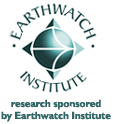Expedition Basics
Before I decided to do this as a blog, I started creating a website that I could use to share my experiences. I thought it might be useful to share some of the information from my draft of that website here, so that people can get an idea of what the whole thing is all about.
What is Earthwatch?
As a science-based organization operating in more than 50 countries worldwide, Earthwatch’s mission is to engage the public in scientific field research and education in order to promote the understanding and action necessary for a sustainable environment. Earthwatch Institute is one of the largest private supporters of critical field research. Through Earthwatch, the public has an opportunity to become directly involved in the research process. It is hoped that this involvement will lead to a greater understanding of a need for conservation efforts around the world.
Earthwatch expeditions are lead by researchers who are highly respected scientists in their fields. Volunteers assist these researchers in the field in a variety of ways, depending on the project. Researchers and volunteers work and live together at field sites in some of the most amazing locations in the world.
For more information on Earthwatch Institute, visit the website at http://www.blogger.com/www.earthwatch.org.
What is the Kenya expedition?
The expedition I’ll be participating on is one of Earthwatch’s Conservation Research Initiatives. The program is called Samburu Wildlife and Communities. The goal of this project is to work with the local people of the Samburu- Laikipia region to assess the use of land and develop sustainable conservation strategies. Researchers study wildlife like Grevy’s zebras, carnivores like lions, water resources, and human land-use to find out where people and nature are in conflict. These studies can then help the local pastoralists better manage and protect the land and the incredible wildlife of the region. Earthwatch’s programs in the region work out of 2 locations: Wamba in the unprotected Samburu area and the protected area of Lewa.
I will be part of Team 13, which will be participating in 2 research programs at the Wamba site. The first is the Carnivores in Conflict program; the second is Communities, Water, and Wildlife. The Carnivores in Conflict program studies how large predators in the Samburu region interact with livestock and humans. By tracking animals with VHF collars and motion sensor cameras and surveying local communities about the killing of livestock by different predators, researchers hope to help local herders find ways to best protect their animals from predator attacks. The carnivores studied are mostly cheetahs, lions, leopards, and hyenas. The second program—Communities, Water, and Wildlife—studies the water resources in the Samburu region. Most of this region has an arid or semi-arid climate, so water is a limited resource. Humans, livestock, and wildlife are all in competition for this resource, which makes water the most important resource in the area. Researchers use GPS devices to map water sources, try to estimate the amount of water available at different times of the year, and test the water to find its chemical make up and how safe the water is for humans and animals to use.
For information about the Conservation Research Initiative in Samburu, click here.
How did I get involved?
I’d heard of Earthwatch before, because they were involved in research in Madagascar while I was in the Peace Corps there. However, I had no idea that Earthwatch provided opportunities to teachers until Mr. Wachtelhausen went to Iceland on an Earthwatch expedition last summer. He told me about the Education Fellowship program and encouraged me to look at the expeditions available. As luck would have it, there were a bunch of expeditions that seemed to fit the World Geography curriculum at HMS. I filled out an application (I had to write 2 essays and get letters of recommendation from Mr. Boddie and Mr. Kirkcaldy), and in February I found out that I had been awarded a fellowship. Through a grant from the Sheehan Family Foundation, Earthwatch is able to give me a fellowship that will cover the cost of the expedition to Kenya. In exchange, I will keep a journal, write a lesson plan, take pictures on the expedition, and write press releases before and after the expedition.






0 Comments:
Post a Comment
<< Home